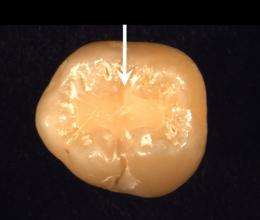Researchers are reporting progress toward a stronger material for dental cavities using ingredients from the human body. Arrow points to a filling made of "composite." Credit: National Institute of Standards and Technology
Scientists in Canada and China are reporting development of a new dental filling material that substitutes natural ingredients from the human body for controversial ingredients in existing “composite,” or plastic, fillings. The new material appears stronger and longer lasting, as well, with the potential for reducing painful filling cracks and emergency visits to the dentist, the scientists say. Their study appears in the current edition of ACS Applied Materials & Interfaces.
Julian X.X. Zhu and colleagues point out that dentists increasingly are using white fillings made from plastic, rather than “silver” dental fillings. Those traditional fillings contain mercury, which has raised health concerns among some consumers and environmental issues in its production. However, many plastic fillings contain controversial ingredients (such as BisGMA) linked to premature cracking of fillings and slowly release bisphenol A, a substance considered as potentially toxic to humans and to the environment.
The scientists developed a dental composite that does not contain these ingredients. Instead, it uses “bile acids,” natural substances produced by the liver and stored in the gallbladder that help digest fats. The researchers showed in laboratory studies that the bile acid-derived resins form a hard, durable plastic that resists cracking better than existing composites.
More information: Applied Materials & Interfaces , “New Dental Composites Containing Multimethacrylate Derivatives of Bile Acids: A Comparative Study with Commercial Monomers”
Source: American Chemical Society (news : web)





















